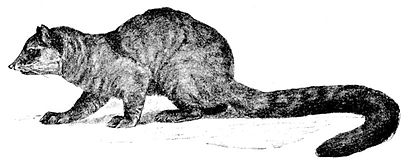fish and it also captures fish. Not only is this animal partially aquatic, but it can climb well—"they make their homes in trees, but carry on their business elsewhere." The animal can be readily tamed, but is a tiresome pet on account of its insatiable curiosity and its skill in the use of its hands, which enables it to unlatch doors and generally to pry about everywhere. The Raccoons are mostly nocturnal creatures.
The genus Bassaricyon[1] includes two species, both American, B. alleni being from Ecuador, and B. gabbii from Costa Rica. They have so much the aspect of a Kinkajou that a specimen, which arrived at the Zoological Gardens, was presented and entered as one of those animals. Nevertheless there are many differences between the two genera. The tail of Bassaricyon is not prehensile, and the animal, as will be seen from Fig. 214, has a sharper snout; the brain is more like that of Bassariscus. The likeness to Cercoleptes can hardly perhaps be regarded as an example of "mimicry" since the forms are so nearly related, and the advantage of such an imitation remains to be proved. The muzzle of Bassaricyon is grooved; the ears are fairly large; the soles of the feet are naked; there is but a single pair of teats. There are two molars and four premolars to each half jaw.

Fig. 214.—Bassaricyon. Bassaricyon alleni. × 1⁄5.
The dorsal vertebrae are thirteen in number; nine of the ribs reach the sternum. The slenderness and convexity of the lower margin of the lower jaw, as well as the feeble angular process, distinguish this genus from its undoubtedly near ally Cercoleptes. The dental formula also is different.
Bassariscus has a ringed tail like a Raccoon, and is also American in range; it furthermore agrees with the Raccoon in
- ↑ See Beddard, Proc. Zool. Soc. 1900, p. 661, for anatomy.
